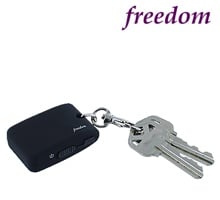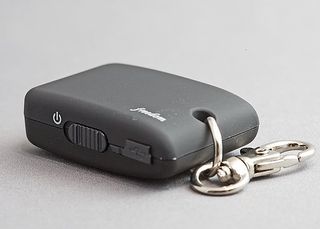Review: Freedom Keychain GPS 2000


Mapping software has been available for cell phones, laptops, and pdas for years. When Rand McNally, DeLorme and other mapping companies first introduced these software packages, GPS compatibility was inevitable. While phones such as the Samsung BlackJack II have begun to incorporate GPS into the phone itself, many rely on external GPS receivers either connected through an expansion port, cable or Bluetooth.
As technology advances, these receivers seem to get smaller and faster. The best illustration as to how small and fast these devices have become may be the Freedom Keychain GPS 2000 ($89.95).
WMExperts reviewed the original Freedom Keychain back in December and found it a surprisingly good bluetooth GPS unit. What do you do when you have a surprisingly good Bluetooth GPS Unit? Scrap it and replace it with a better one!
Read on for the full review!
Out of the Box
The GPS 2000 is about the same size of an automobile keyless entry control. Measuring 1.8 x 1.26 x .58 inches, the receiver is a feather light .77 ounces. A spring hook is attached to the top of the device so the receiver can be carried on a key chain.
The power switch and USB/charger port are the only external parts. Colored LEDs run under the matte black finish to indicate charging status, GPS signal, Bluetooth Signal and battery status.

The receiver is finished in a black matte paint that is a little susceptible to finger prints and I can see it wearing off after being carried around with a bunch of keys. During the testing of the receiver, I could begin to see light wear on the finish. I am not sure if due to an antenna/reception issue the company couldn’t have used a more durable coating on the device or not. I doubt a worn finish will affect the performance and is mainly a cosmetic issue.
Get the Windows Central Newsletter
All the latest news, reviews, and guides for Windows and Xbox diehards.
I was impressed with the receiver’s small form factor but had to raise an eyebrow questioning the unit’s performance. I am glad no wagers were place on this device because I would have had to eat crow.
Performance
When you pull the owner’s manual out of the box, it’s impressively thick. Once you begin to read it, you realize the thickness is due to the manual being written in ten languages. The actual instruction for use is only two pages.
In reading the brief owner’s manual, Freedom reports that satellite acquisition time ranged from 36 seconds for a cold start and 1 second for a hot start. As I understand it, a cold start is when the receiver has been off for a while and has lost all memory of the satellite signals. Hot start is when the receiver has only been turned of for a brief period of time and the signal with the satellites hasn’t faded from memory.
The start times reported are exceptionally good and more common for larger, stand alone devices than receivers the size of a matchbox and again my eyebrow raised in doubt as I began to use the receiver.
Pairing is easy. Turn on your phone’s Bluetooth, turn on the GPS 2000 and once the device is discovered, you enter the top-secret factory code. I then went to Google Maps, selected “Use GPS” and to my surprise the signal was already acquired and my position located. While I didn’t have a stopwatch running it couldn’t have taken more that two minutes from the time I turned on the phone’s Bluetooth to seeing the little map dot pinpointing my location (I could feel my eyebrow lowering).
I turned off the GPS in Google Maps, turned off the GPS 2000 and grabbed a stop watch. After waiting five minutes, I turned everything back on and 34 seconds later, I had my position plotted. I also tried the GPS 2000 with Live View and the results were equally as impressive.
Concerned the maybe the built-in GPS of the BlackJackII may be inadvertently boosting the GPS 2000; I tried it with my laptop. Using the receiver indoors, sitting on a table next to a window, it took 1.5 minutes for Microsoft’s Streets and Trips to acquire a location from a cold start.
I have a TomTom XL sitting on the dash of my car. To give you a comparison, from a cold start it takes the TomTom just overr 1.5 minutes to boot up and acquire a signal. It takes my Garmin handheld GPS almost 3 minutes to acquire a signal from a cold start. I was very impressed with the GPS 2000’s acquisition times.

The speed of the acquisition is attributed to the GPS 2000’s chipset. The GPS 2000 uses a MTK chipset and a built in ARM7EJ-S processor. After a brief education on GPS chipsets, apparently the MTK chipset is slowly replacing the SiRF III chipsets. The MTK has lower power consumption, an active antenna, can track more satellites, has more accurate positioning and about a 6 second advantage on cold start acquisitions.
While start up time was off the wall, reception was equally cool. Freedom claims in the GPS 2000 even works while in your pocket. My first thought was “utter hogwash”. An overcast day kills the signal on most GPS receivers and I’m to believe this tiny receiver will work while in my pocket?
Yet another instance where I’m glad no wager was placed on the performance of the GPS 2000. After sliding the receiver in my pants pocket, I full expected a “signal lost” or “GPS unavailable” to pop up on the BlackJack’s screen. I watched, waited and nothing happened. So I decided to drive down the road a bit and to my surprise, my location began to adjust with my movement. This tiny little receiver works in your pocket!
As mentioned, it will pick up signals indoors as far a window is close by. It will also pick up signals on an overcast night. While the reception is as impressive as the acquisition time, the receiver does have limitations in that it will not pick up a signal while in a concrete, windowless basement.
I had no issues with pairing the Freedom GPS 2000 with my laptop or BlackJack II. The only difficulties I had while using the GPS 2000 was with the programs utilizing the receiver and not the receiver itself. While some of the software applications weren’t user friendly, the Freedom GPS was extremely user friendly.
Freedom reports battery life to be approximately 10 hours. Based on my three day review, this report is accurate. The only performance drawback that I could find is the options available to recharge the receiver. The GPS 2000 comes packaged with a USB/Charging cable to allow you to charge the unit through your computer and a car charger. I could not find any information to believe a wall charger is available for the receiver.
Overall Impression
After using the GPS 2000, all I can say is “WOW”! Competitively priced with other Bluetooth GPS receivers, the GPS 2000 is a dependable receiver and its compact size makes it convenient to have available.
It would be nice if the GPS 2000 had a wall charger and the matte black paint could be more durable. However, these two deficiencies do not detract from the unit’s performance.
If you are looking for a GPS solution for your phone, laptop or pda the Freedom Keychain GPS 2000 ($89.95) should be high on your short list.
| Ratings (out of 5)Pairing/Connectivity: 5/5Ease of Use: 5/5Build: 4.5/5 (paint job could be better)Battery Life: 5/5Value: 5/5Overall: | ProsSizeSizeDid I mention size?Speed of AcquisitionSignal strength between receiver and phone/laptop/pdaConsNo wall outlet charging option |
Home to the most invested and passionate Microsoft fans, Windows Central is the next generation destination for news, reviews, advice and buying recommendations on the Windows, PC and Xbox ecosystems, following all products, apps, software, AI advancements, and accessories. We've been around for more than decade, and we take our jobs seriously. Windows Central writers and editors value accuracy and editorial independence in everything we do, never receiving compensation for coverage and never pulling punches.
